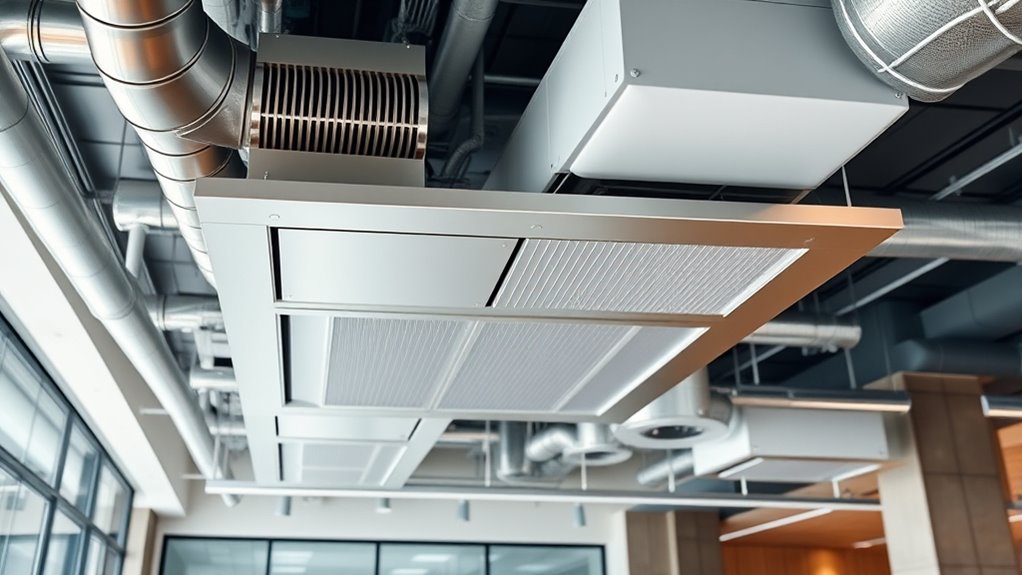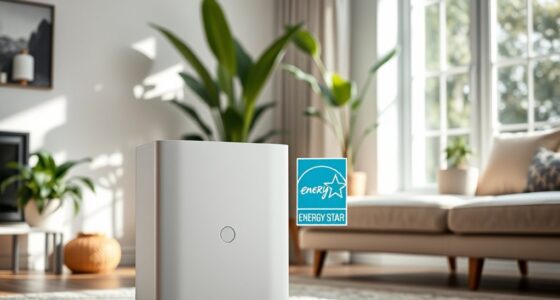To meet RESET Air standards in commercial interiors, you need advanced sensors that monitor air quality parameters like CO2, humidity, and VOCs continuously. Your ventilation system should be designed to provide an adequate, balanced rate tailored to occupant activity levels, and it should automatically adjust based on sensor data. Proper filtration and collaboration with knowledgeable HVAC professionals are essential. If you keep going, you’ll discover how these elements come together for healthier, more comfortable spaces.
Key Takeaways
- Continuous monitoring of indoor air quality parameters like CO2, VOCs, and humidity is essential.
- Advanced sensors must be integrated to provide real-time data for automatic ventilation adjustments.
- Ventilation rates should be balanced and tailored to occupancy levels and activity types.
- High-quality filtration systems are required to remove pollutants and improve air freshness.
- Collaboration with HVAC professionals ensures systems meet RESET Air standards for optimal performance.

In commercial interiors, maintaining healthy air quality is essential for occupant well-being and productivity. You need to guarantee that the indoor environment promotes comfort while also meeting established standards. One critical aspect of this is adhering to ventilation standards, which dictate how air is circulated and refreshed within a space. Proper ventilation isn’t just about moving air; it’s about bringing in enough fresh outdoor air and exhausting stale indoor air to sustain ideal indoor air quality. When ventilation standards are met, it helps remove pollutants, control humidity, and reduce airborne contaminants, creating a healthier environment for everyone inside.
Maintaining proper ventilation is key to healthy, comfortable indoor air quality in commercial spaces.
As you focus on indoor air quality, you’ll want to pay close attention to how ventilation systems are designed and maintained. Good indoor air quality isn’t just a matter of air exchange; it’s about controlling sources of pollution, such as VOCs (volatile organic compounds), particulate matter, and other indoor pollutants. That’s where standards like RESET Air come into play. RESET Air, developed by the U.S. Green Building Council, sets specific benchmarks for indoor air quality that go beyond traditional ventilation requirements. It emphasizes continuous monitoring and real-time data to ensure ventilation systems operate at their best, providing occupants with cleaner, healthier air.
Implementing RESET Air standards means you’ll need to guarantee your commercial interiors are equipped with advanced sensors that monitor air quality parameters like CO2 levels, humidity, and volatile organic compounds. These sensors should feed data into control systems that automatically adjust ventilation rates to maintain healthy indoor air quality at all times. This proactive approach helps prevent issues like stale air buildup and high pollutant concentrations, which can impact occupant health and comfort. It also aligns with the goal of creating spaces that are energy-efficient while prioritizing occupant wellness.
Meeting RESET Air requirements involves more than just installing sensors; it demands a detailed strategy that integrates high-quality air filtration, balanced ventilation rates, and continuous oversight. You’ll need to work with HVAC professionals who understand the importance of these standards and can design systems that respond dynamically to changing indoor conditions. This ensures the environment remains within the ideal range for air quality, regardless of occupancy levels or activities happening inside. Additionally, incorporating high refresh rates enhances the effectiveness of air exchange, further supporting a healthy indoor environment.
Ultimately, adhering to RESET Air standards for ventilation and indoor air quality means you’re prioritizing health, comfort, and sustainability in your commercial interiors. It’s about creating spaces where people can work, learn, and collaborate without worrying about pollutants or poor air circulation. By focusing on these key requirements, you’re not just meeting regulatory standards; you’re establishing a healthier, more productive environment that benefits everyone who spends time there.
Frequently Asked Questions
How Often Should RESET Air Certifications Be Renewed?
You should renew your RESET Air certification every three years to maintain ideal air quality standards. Regular certification renewal ensures that your commercial interiors meet the latest industry benchmarks for air quality, keeping your indoor environment healthy and compliant. Stay proactive by tracking your certification expiry date and scheduling renewal well in advance. This way, you ensure continuous compliance, safeguarding occupant health and demonstrating your commitment to high indoor air quality.
What Is the Cost of Obtaining RESET Air Certification?
You can expect the cost of obtaining RESET Air certification to range from $2,000 to $5,000, depending on your project’s scope and size. During the certification process, you’ll need to demonstrate your commitment to maintaining high air quality standards through thorough documentation and on-site assessments. This investment guarantees your commercial interiors meet sustainable and health-focused benchmarks, ultimately improving air quality and demonstrating your dedication to a healthier indoor environment.
Are There Specific Industry Standards Aligned With RESET Air?
You might wonder if specific industry standards align with RESET Air. The answer is yes; it adheres to rigorous certification standards focused on improving indoor air quality. These standards emphasize reducing airborne contaminants, ensuring healthier environments. By following these guidelines, you demonstrate a commitment to superior indoor air quality, meeting industry expectations and providing peace of mind for occupants. This alignment elevates your project’s credibility and showcases your dedication to healthier indoor spaces.
Can Existing HVAC Systems Meet RESET Air Requirements?
Your existing HVAC system might meet some air quality and ventilation standards, but it likely needs upgrades to fully comply with reset air requirements. These standards focus on maintaining ideal indoor air quality through improved ventilation and filtration. To guarantee your system aligns with reset air standards, you should evaluate its current performance, upgrade components if necessary, and possibly incorporate advanced controls for better air quality management.
How Does RESET Air Certification Impact Building Valuation?
Think of your building’s value as a thriving garden; earning Reset Air certification standards is like adding a vibrant bloom that attracts positive attention. This certification boosts indoor air quality, making your space more appealing, healthy, and efficient. When your building meets these standards, it signals a commitment to excellence, which can enhance valuation, attract tenants, and improve your reputation—all essential for a flourishing, sustainable property that stands out in the market.
Conclusion
Just like a well-tuned orchestra, your commercial interior relies on RESET Air standards to harmonize health, comfort, and sustainability. When you prioritize these key requirements, you’re not just creating a space—you’re inspiring a future where clean air fosters productivity and well-being. Remember, the choices you make today echo through tomorrow, reminding us that true progress is achieved when we set the right tone now. Embrace RESET Air, and let your space be a beacon of mindful innovation.










